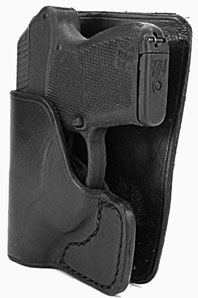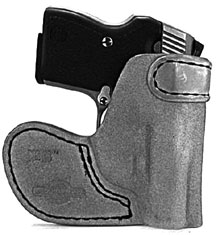
Carrying a pistol or revolver in one’s pocket presents three basic problems: 1) Disguising the weapon; 2) Making sure it stays in position; and 3) Protecting it from foreign objects that can interfere with grabbing it or preventing the gun from firing.
Lint can jam a pistol. Pens or knives may prevent the hand from acquiring the weapon. Loose coins can get caught in the trigger guard and hinder moving the trigger, or worse yet press the trigger past the point of ignition. A gun in the pocket can easily shift out of position, making it difficult to draw. Without a holster that smooths out its telltale lines, a gun in the pocket will appear from the outside as simply, a gun in a pocket.
Two popular pocket holster designs are represented by the “Cookie” model ($35 from Graham’s Leather, info@graham-holsters.com), and by the HPT-32MRC ($65 from Mitch Rosen Extraordinary Leather, 603-647-2971). Both holsters are constructed from cowhide.
The Cookie is designed to disguise the holster and gun as a wallet, so back-pocket carry is the intention. The obvious deception in this mode of carry is compliantly handing over one’s wallet, precluding the draw. The holster portion of the Cookie is shielded by a hard-leather rectangle that is finished in rough leather on the outer surface to grip fabric.

The retention portion of the design allows for the fingers to reach in past the shield and acquire the gun without the danger of slipping a finger inside of the trigger guard. When the gun is drawn the holster, much like a stubborn wallet, stays in the pocket.
The Mitch Rosen HPT-32MRC we purchased was designed for the NAA Guardian pistol tested elsewhere in this issue. It relied upon a hook-like portion of hard leather to anchor the gun inside the pocket. The retention portion otherwise appears to be a standard holster, but inside a back pocket the overall profile is rectangular when the eye connects the wide lower portion of the holster and the square dimensions of the pistol. We found the pistol very easy to acquire safely, but more often than not the gun and holster came out together. We thought this was due to there not being enough friction between holster and the pocket and there being too much friction between the holster and the gun.
Gun Tests Recommends
Graham’s Leather Cookie, $35. Best Buy. Did the job of disguising, retaining, and protecting a pocket pistol simply and cheaply.
Mitch Rosen Extraordinary Leather HPT-32MRC, $65. We think this system is less versatile than the design of the Cookie because special care in matching the Mitch Rosen HPT/32MRC to garments is required.
———-
Hi-Point Update
As reported in February, our first experience with the Hi-Point JHP .45 ACP was plagued with the inability to chamber a variety of factory rounds. But after following the advice of the manufacturer, we limbered up the .45 JHP by forcing the slide back and forth and even hand-cycling a quantity of rounds. We contacted a number of qualified gunsmiths, and they said that hand cycling does not really tell you much about the gun’s ability to function and of course it is inherently dangerous. We join in their opinions that a post-sale regimen such as this should never be required of any firearm.
Nevertheless, we were able to fire enough rounds from this gun to gather meaningful data. Accuracy with theHi-Point was satisfactory at 15 yards, and if we considered only this factor, we would happy with this $159 gun. However, none of the rounds we tried were completely reliable from a bench rest. The worst offender was the Winchester 185-grain FMJ ammunition with a truncated cone shape. In an earlier session shot standing at 7 yards, the gun seemed to work itself out and shot reliably.
Why then the problems at the bench? Most likely because with the gun held tightly in a natural standing position, the gun had a better foundation from which to work. With a sandbag rest some of the control was given up to the sandbags. But, we feel that a defense gun must function from any stance imaginable. After all, a defensive situation may require single-handed fire or controlling the gun despite injury.
We had five magazines, but it was hard to trace problems to a specific magazine. They all were painfully annoying to load.
Gun Test Recommends
We think this gun would be a buy at $100 more if it ran reliably, but it didn’t. Thus, we wouldn’t buy it.
Also With This Article
[PDFCAP(1)]


























